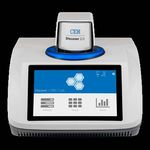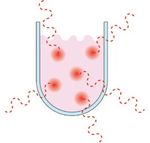Academic Solutions Microwave Synthesis Systems and Teaching Materials - Undergraduate Instruction
←
→
Page content transcription
If your browser does not render page correctly, please read the page content below
Academic Solutions
Microwave Synthesis Systems and Teaching Materials
Undergraduate Instruction
Graduate Research
Advanced Microwave Technology
We Simplify ScienceReal World Education
Expose your students to the most modern methods and the complex chemistries that they will be using after
graduation, including multi-step and multi-component reactions that you currently cannot teach due to time
restrictions. Microwave energy has become the method of choice for chemists, as it offers the safest, most
effective way to increase reaction rates and improve product yields, while promoting green chemistry. The
Discover® 2.0 and MARS 6™ Synthesis microwave synthesizers from CEM provide users with the safety,
flexibility, and reproducibility demanded by teaching and research laboratories no matter the size of the group.
Literature
Clean, Fast Organic Chemistry:
Microwave-assisted laboratory experiments
Not sure how to integrate a microwave into your existing class? The authors of Clean, Fast Organic Chemistry have taken many standard
organic chemistry experiments and converted them to utilize microwave assisted heating techniques and green chemistry principles.
Experiment Type Reflux Conditions Microwave Conditions
Diels-Alder 90 minutes in DMF 10 minutes in H2O
Williamson Ether Synthesis 60 minutes in H2O 10 minutes in H2O
Aldol Condensation 23 hours in H2O 15 minutes in H2O
Bromination 45 minutes in HOAc 8 minutes in HOAc
Nucleophilic Aromatic Substitution 60-90 mins in Toluene 10 minutes in EtOH / H2O
Hydrolysis 34 hours in MeOH / H2O 9-15 minutes in MeOH / H2O
= Green chemistry experiment
Instructor’s Edition Microwave Energy
Microwave irradiation is a form of energy that falls between 300 and 300,000
Hertz: Unit of measurement megahertz (MHz), relatively low on the electromagnetic spectrum. (Figure 1)
of frequency, numerically Unlike ultraviolet radiation, which is used in photochemistry and can break
equal to cycles per second.
chemical bonds, microwaves are low frequency forms of energy that only cause
the molecules to rotate.
methods. With microwave irradiation, since the energy is interacting with the
Microwave heating is
molecules at a very fast rate, the molecules do not have time to relax and the heat
The energy of a microwave significantly more efficient
at a frequency of 2.45 GHz is generated can be, for short times, much greater than the overall recorded temperature
than conventional heating.
0.0016 electron volts (eV). About 80% of the power of the bulk reaction mixture. In essence, there will be instantaneous localized
consumed by a microwave superheating. (Figure 5)
The average energies of some oven is used to heat food
common chemical bonds are compared to as little as 10%
as follows: for conventional ovens.
C-C single bond = 3-4 eV
C=C double bond = 6-7 eV
O-H bond = 4-5 eV
Figure 1. The electromagnetic spectrum
Like all electromagnetic energy, microwaves move at the speed of light and are
comprised of oscillating electric and magnetic fields. (Figure 2) These fields swing
back and forth at right angles to each other, perpendicular to the source of the
energy. It is primarily the electric field of the microwave which interacts with
molecules and causes the transfer of energy and the generation of heat.
Figure 5. Localized superheating of molecules in solutions
The rate of a reaction is described by the Arrhenius equation, which expresses the
relationship between the rate of reaction and the activation energy, Ea. (Figure 6)
The Arrhenius equation is a
simple, yet very accurate
predictor of the reaction rate.
Figure 6. Arrhenius equation
Figure 2. A microwave The activation energy is the energy barrier that must be overcome in order for the
2 reaction to occur. A microwave transfers energy to the reaction every nanosecond
(10-9 seconds). The almost constant energy input is achieved at a rate greater than
the molecular relaxation rate, which is on the order of 10-5 seconds. Because the
energy is added at a rate faster than the molecules are able to relax, all of the
molecules in solution will be in a constant state of disequilibrium, providing more
than enough energy to overcome the activation energy barrier (Ea) and drive the
reaction to completion. (Figure 7)
4
1Lab Safety Go Green
Not only is microwave-assisted chemistry good for the It’s time to think about the environment and our impact on
environment, it is also safer for chemists. Microwave synthesis it. Microwave energy is an inherently efficient way to transfer
systems designed for the laboratory offer an unmatched level energy to a reaction, as it is transferred directly to the reaction
of safety. solution. Because of this quality, it is the ideal energy source
for driving reactions.
• Eliminate hot plate burns
• Reactions return to room temperature before • Use water, ethanol or other environmentally
removing from microwave benign solvents
• Reactions are completely contained • Neat reactions/high conversions help eliminate waste
• Laboratory grade microwave systems provide • Non-hazardous reagents help students design
monitoring and feedback control of temperature, safer syntheses
pressure, and stirring to ensure maximum safety and • Use catalysts, not stoichiometric reagents
reproducibility in the lab.
2Microwave Heating 101
Convective Heating
Reactions typically covered in academic organic laboratories
rely on convective heating, a method in which energy is
transferred indirectly to the reactants by applying heat to the
outside surface of the vessel. This form of heating is very
slow and inefficient which is why many experiments require
lengthy reflux times and leave little time for characterization,
purification or repetition.
Microwave Heating
With microwave heating, the vessel wall becomes virtually
transparent to microwaves allowing energy to be directly
absorbed by the reaction and provide instantaneous activation
or localized super-heating of the molecules in solution. This
direct molecular activation limits side reactions and provides a
fast and efficient form of heating. Reactions that previously took
hours, or even days, to complete can be performed in minutes.
3Microwave Solutions for Your Lab CEM offers two microwave platforms for synthetic chemistry: the Discover 2.0 and the MARS 6 Synthesis. The Discover 2.0 is a sequential system, which is best suited for a smaller class size and split research/teaching needs. It can also be utilized in a larger lab section where students work in groups and coupled with an auto-sampler for high-throughput labs. The MARS 6 is a parallel reactor designed for batch processing of reactions. The ability to run multiple reaction vessels simultaneously is advantageous for large teaching laboratories, as it only takes 30 minutes to complete a set of up to 36 vessels. Discover 2.0 Ideal for classes of 12 students or less The Discover 2.0 is a single mode, sequential microwave system which allows significant flexibility in the teaching lab, as students can explore different reaction parameters and work with various substrates and solvents. The sequential format is ideal for classes of 12 students or less, but also fits in classes with a larger number of students who work in groups. The Discover is also the system of choice for research laboratories performing initial investigative syntheses and chemistry optimization with a variety of accessories available, including automation decks. MARS 6 Synthesis Ideal for classes of 13 students or more The best-selling MARS 6 is a multi-mode microwave system that provides parallel reaction processing, making it ideally suited for teaching laboratories. With the ability to accommodate up to 36 pressurized vessels or up to a 5 L open flask, the MARS 6 offers both high-throughput for larger lab sections and flexibility to run batch syntheses. In addition to accommodating synthetic chemistry, the MARS 6 can also be used for solvent extraction and acid digestion for metals analysis. 4
Nucleophilic Aromatic Substitution
Complete in 10 minutes or less in the microwave.
CH2CH3
Br HN
NO2 NO2
EtOH
CH3CH2NH2
µw, 125 °C
NO2 NO2
Discover 2.0 MARS 6 Synthesis
Maximum Reaction Vessels 1 36
Solvent: Ethanol 3 mL 5 mL
Reagent: 1-Bromo-2,4-dinitrobenzene 0.298 g 0.298 g
Reagent: Ethylamine (70% aqueous) 0.380 mL 0.380 mL
Reaction Time 6 minutes 10 minutes
Cool-down Time 2 minutes 20 minutes
Leadbeater, N. E.; McGowan, C. B. Clean, Fast Organic Chemistry: Microwave-assisted laboratory experiments. 2006, CEM Publishing.
5cem.com
Over 50,000 CEM has been an All systems serviced & CEM invests 12% of IQ/OQ/PQ
systems sold ISO-certified facility supported by experts annual revenue into Validation by
worldwide since 1994 with an average of 15 R&D, the result... certified CEM
years of experience 11 R&D 100 awards Technicians
United States France Germany, Austria, Ireland
(Headquarters) Switzerland
33 (01) 69 35 57 80 +353 (0) 1 885 1752
800-726-3331 info.fr@cem.com (49) 2842-9644-0 info.ireland@cem.com
704-821-7015 info@cem.de
info@cem.com
Italy Japan United Kingdom
(+39)035896224 +81-3-5793-8542 (44) 1280-822873
info.srl@cem.com info@cemjapan.co.jp info.uk@cem.com
For distributors in other regions, visit cem.com/contact
B052v9
© 2020 CEM Corporation. All Rights Reserved. 07/20You can also read



























































